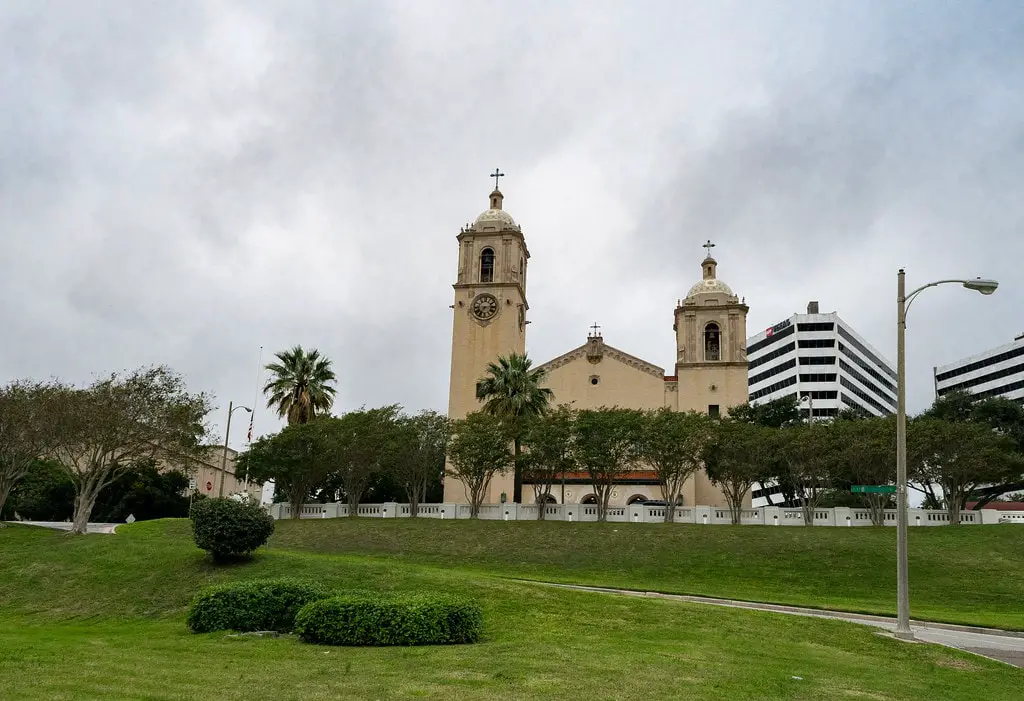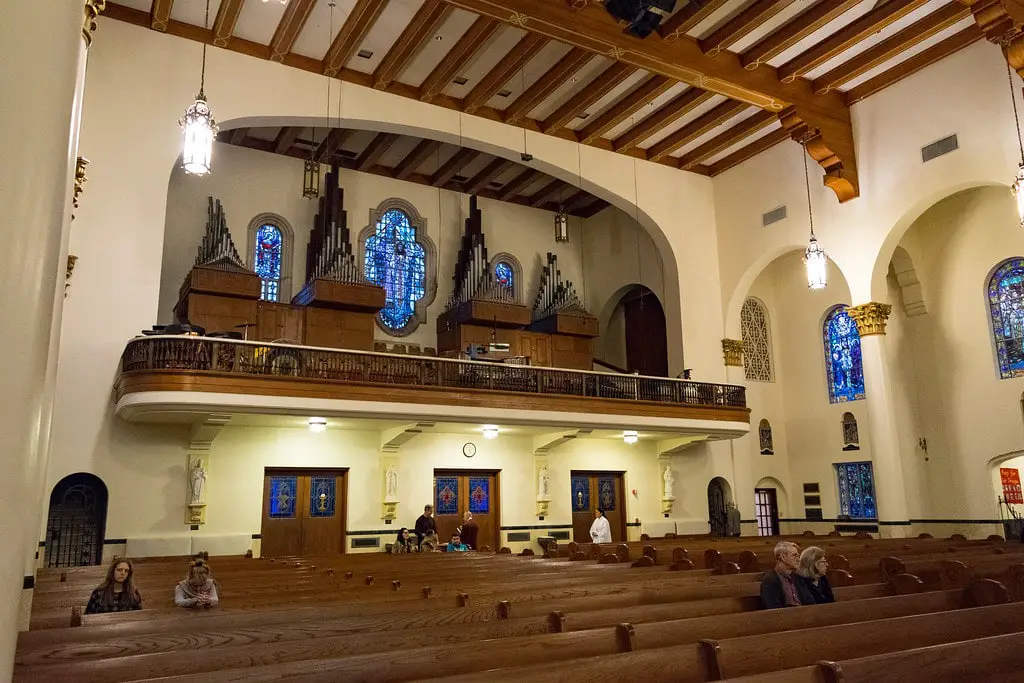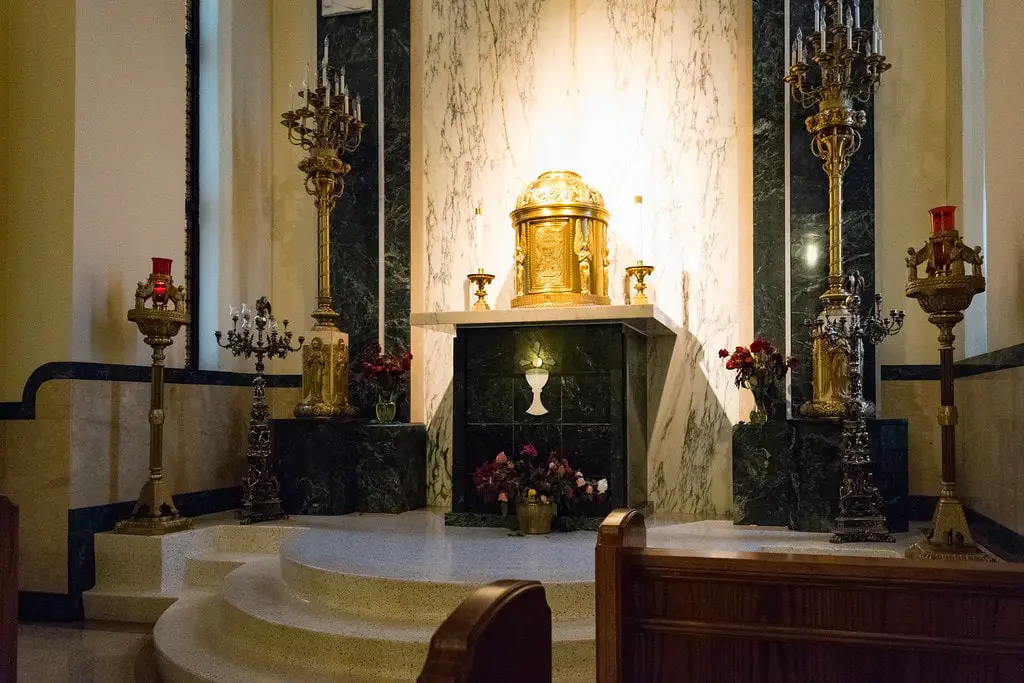Historical Background
A tale as old as time echoes through the hallowed halls of the Corpus Christi Cathedral. In the early years, the story of faith in Corpus Christi, Texas, was a tale of resilience and devotion.
When there were no church buildings, priests would journey from places as distant as Laredo and Victoria to cater to the spiritual needs of the Catholics in the area. Mass was celebrated in the warmth of private homes, fostering a sense of community beyond any church’s walls.
The first pastor assigned to Corpus Christi was Rev. Bernard O’Reilly, sent by Bishop Jean-Marie Odin of Galveston. By 1855, the faithful community had a small adobe church to call their own, even before the structure was fully completed.
The land for the church, enclosed by Leopard, Tancahua, Antelope, and Caranchua Streets, was generously donated by H. L. Kinney. Owing to the parish’s many Irish immigrants, the church was named St. Patrick’s.
St. Patrick’s Cathedral endured the test of time and weathered many a storm. St. Patrick’s stood firm from establishing the Vicariate Apostolic of Brownsville in 1874 to create a larger church due to the need for repair.
It even provided refuge for those displaced by the destructive hurricanes that hit Corpus Christi in 1916 and 1919. However, a fire in November 1938 marked a turning point in the cathedral’s story.
The Building of Corpus Christi Cathedral
Before the fire, the parish and the diocese had already started to outgrow the old cathedral church. Thus, the decision to build a new church was taken. The land for the new church was donated by John Kenedy, marking the genesis of a new chapter in the story of Corpus Christi’s faithful.
Designed in the Spanish Colonial Revival style by Charles Monot, the new cathedral was a sight to behold. The cornerstone was laid on March 1, 1940, and by July of the same year, the cathedral was dedicated by Bishop Emmanuel Ledvina.
This magnificent edifice measured 176 feet in length and 90 feet in width, with the south tower reaching 125 feet to the top of the dome and 133 feet to the top of the cross.
A remarkable event accompanied the cathedral’s dedication. Pope Pius XII expressed his desire for the cathedral’s name to be changed to Corpus Christi, and thus, the name was changed during the dedication ceremony. The St. Patrick’s buildings were rebuilt and given a new identity as the Our Lady, Star of the Sea Church.

Renovations and Modern Developments
As the winds of change swept across the Catholic world in the 1960s, Corpus Christi Cathedral was not left behind. Bishop Thomas Drury renovated the cathedral to reflect the liturgical differences from the Second Vatican Council. These changes marked a significant development in the life of the cathedral and its congregation.
In the following years, under the pastorate of Msgr. Richard Shirley, the Cathedral Concert Series was initiated, adding a new dimension to the cathedral’s offerings. The parish also began participating in ecumenical outreach programs in the community, further expanding its influence.
In 1979, a chapel was created in the cathedral’s crypt for daily Mass, and a new rectory was built. The cathedral underwent another round of renovation in 1980, ensuring its continued relevance and appeal.
By the 1980s, a weekly televised Mass originated from the cathedral, bringing the cathedral’s message to a broader audience.

Remembering Msgr. Richard Shirley
One name stands out prominently in the Corpus Christi Cathedral annals – Msgr. Richard Shirley. Born and raised in Corpus Christi, Shirley was ordained in 1967 at the Corpus Christi Cathedral, a parish where he would later serve as a rector. Pope John Paul II named him a Prelate of Honor in 1981, which bestowed the title of monsignor on him.
Msgr. Shirley served the diocese in numerous capacities, first as a chaplain to the Sisters of the Incarnate Word Convent and later at the Corpus Christi Cathedral, St. Pius X, and St. Patrick Church.
His love for music led to two of Corpus Christi’s most enduring music ventures – the Cathedral Music Ministry in 1984 and the radio station KLUX in 1985.

Beyond his duties within the church, Msgr. Shirley was also known for his community service. He played a crucial role in serving the poor through Catholic Charities, even going as far as serving sandwiches out of the back of the Chancery.
This dedication to serving others also led him to help establish Loaves and Fishes, a soup kitchen that has since become one of the programs run by Metro Ministries.
Conclusion
The Corpus Christi Cathedral is more than a physical structure. It is a symbol of faith, resilience, and community service. It is a testament to the selfless efforts of people like Msgr. Richard Shirley dedicated their life to serving both their church and their community.

It stands tall as a beacon of the Catholic faith in Texas and a testament to the spirit of Corpus Christi – a spirit of resilience, confidence, and service to others.
The cathedral continues to inspire, serve, and bring people together, upholding the values it was built on and adapting to the needs of the present.
